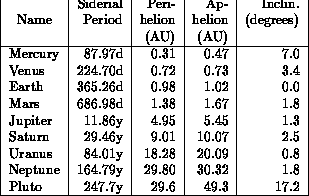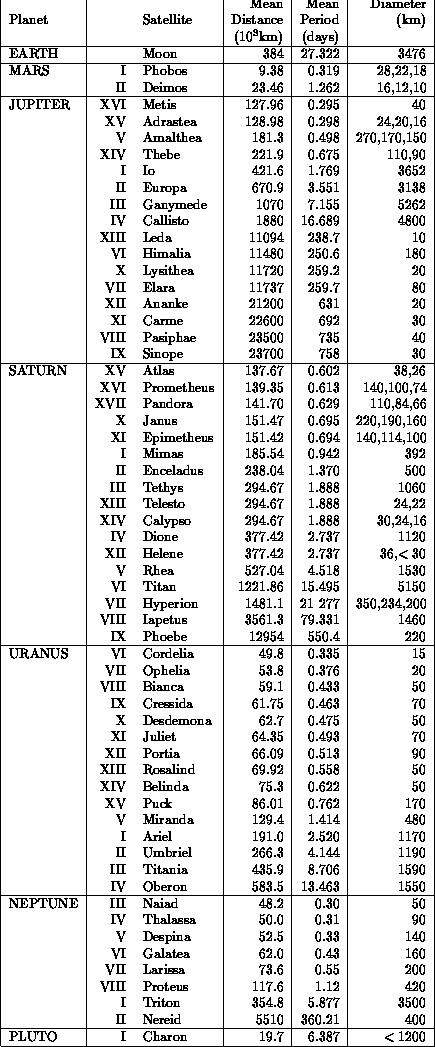Previous: Orbits
Up: The Solar System
Next: The Origin of the Solar System
Solar System Data
Particle Physics and Astronomy Research Council
Royal Greenwich Observatory
_________________________________________________________
Information Leaflet No. 47: 'Solar System Data'
The Orbits of the Planets:

-
The Sidereal Period is the time taken by the planet to return to the same place in its orbit, relative to the stars.
-
Perihelion and Aphelion are the planet's closest and furthest distances from the Sun.
-
ARVAL's Note: The Inclination is relative to the Earth's orbital plane; the plane of the Ecliptic.
The Globes of the Planets:

-
Oblateness is a measure of how much the planet's figure departs from a sphere.
-
The Rotation Period for each planet is the period relative to the stars.
This is slightly different from the period relative to the Sun, which for the Earth we call the day.
-
For the planets Venus, Uranus and Pluto, the inclination of the rotation axis is larger than 90 degrees,
and this planets (and Uranus's satellites) rotate in the reverse sense to that of their orbits.
Otherwise, all the planets, their satellites, and the Sun, rotate and move around the Sun with the same sense of rotation.
Satellites:

Apart from the following, the orbital planes of all satellites are within 5
degrees of the orbital planes of their primary planets:
-
The Moon is between 18-28 degrees.
-
Jupiter XIII, VI, X, and VII, are at about 28 degrees.
XII, XI, VIII, and IX, are at about 150 degrees.
-
Saturn VIII is at 15 degrees, and IX is at 175.
-
Uranus I is at 159 degrees, and II is at 28 degrees.
-
Pluto I is at 99 degrees.
-
The Rings of Saturn have diameters from 134,000 km to 48,0000 km.
The rings about the other planets are not visible from Earth.
-
Where several values are given for the diameter, this indicates that the
satellite is markedly non-spherical. The numbers represent diameters along perpendicular axes.
-
The periods given are sidereal periods of rotation about the planet.
-
The mean distances are given in thousands of kilometres.
Produced by the Information Services Department of the Royal Greenwich
Observatory.
PJA Thu Apr 18 10:43:04 GMT 1996
webman@mail.ast.cam.ac.uk
Note:
Pluto is now a "dwarf planet" by
The IAU definition of "planet" and "dwarf planets"
(August 24 '06).
See Observatorio ARVAL: Solar System Data.
On 13 September '06 the IAU Minor Planet Center assigned to Pluto the asteroid number 134340.
See IAU Minor Planet Center Circular 8747.
 Updated: September 15 '06, June 24 '14
Updated: September 15 '06, June 24 '14
Best seen with Font Verdana.
See About the Web Pages of Observatorio ARVAL.
Back: ARVAL - RGO Leaflets - The Solar System
Messages:
Communications





![]() Updated: September 15 '06, June 24 '14
Updated: September 15 '06, June 24 '14